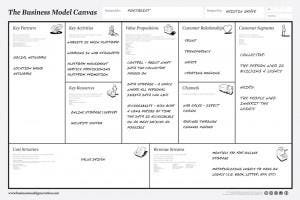
Your business model can make the difference between world-leading success and dismal failure. Just ask the people behind the Xerox 914. In 1959, the first dry-process, plain-paper copier was a potential game-changer — but it cost six times the price of alternatives. Potential partners wouldn’t touch it. So the company developed a new business model. Rather than selling the machine, they leased it for $95 a month and charged a few cents per copy for copies in excess of 2000 a month. Thanks to the 914’s speed and convenience, customers soon were making tens of thousands of copies in the same period, and the copier that couldn’t be sold suddenly became a huge revenue generator.
Alexander Osterwalder wants to encourage that kind of thinking, and he has developed a handy way to do it. His Business Model Canvas is a simple graphical template describing nine essential components: Customer segments, value propositions, channels, customer relationships (such as self service or personal assistance), revenue streams, resources, activities, partnerships, and costs. The individual elements prompt consideration of a business’ full scope, while the layout encourages thought about how the pieces fit together. You can fill in the canvas on a whiteboard; Osterwalder’s book with Yves Pigneur, Business Model Generation, explains how. Or you can play with it interactively using the Business Model ToolBox app for the iPad.
I first heard about the Business Model Canvas from serial entrepreneur turned Stanford/Berkeley/etc. professor Steve Blank, author of the classic marketing manual The Four Steps to the Epiphany. Recently I had the privilege of meeting Osterwalder at Blank’s Northern California coast-side ranch, where the two were collaborating on a new book.
Alexander Osterwalder’s Business Model Canvas
The wiry Swiss entrepreneur, who earned his PhD in management information systems from the University of Lausanne, created the Business Model Canvas after an exhaustive study of existing academic literature on business models. “There were tons of definitions,” he says. “My PhD adviser and I synthesized them into a new model taking the most important pieces. Then we tested it with entrepreneurs.” The idea quickly spread from Northern Europe to the US, where it has been put to use by 3M and Deloitte, adopted by the Lean Startup movement, and incorporated into Blank’s entrepreneurship courses.
The result brings clarity and simplicity to a traditionally fuzzy topic. Using the iPad app, it’s possible to sketch out and evaluate business models in minutes by placing virtual Post-It notes on the Canvas, then drilling down to select options and fill in estimated numbers. Tapping on the tablet’s screen, Osterwalder quickly demonstrates that the $29 app itself isn’t likely to make a viable business — but adding a suite of online tools with a monthly subscription fee, as he has in the works, just might.
Business Model ToolBox iPad app
And Osterwalder eats his own thin-crust pizza . He and Pigneur designed a unique business model for Business Model Generation. They invited members of their Business Model Hub community to contribute for a fee that rose continually throughout the writing. The community revised the text, design, and structure iteratively in preparation for a face-to-face soft launch in Amsterdam. Thus, the book has 470 co-authors who paid as much as $243 for the opportunity.
In Osterwalder’s view, the app and upcoming web site, Strategyzer.com, are the beginning of a new generation of business software dedicated to formulating strategy rather than executing it. These tools will help executives discover new business models, revise them to respond to changing conditions, and manage portfolios of distinct businesses within a large enterprise. For now, though, the Business Model Canvas is simple enough to sketch on a whiteboard — and powerful enough to refocus the way you view your business.
